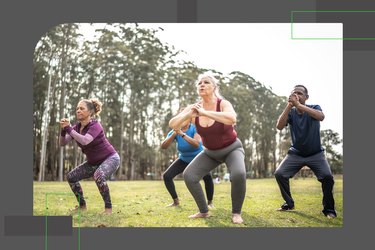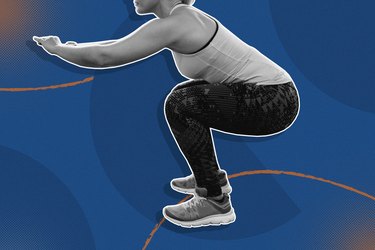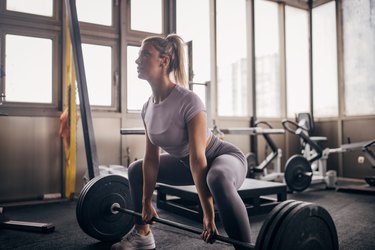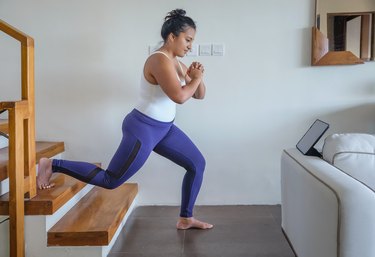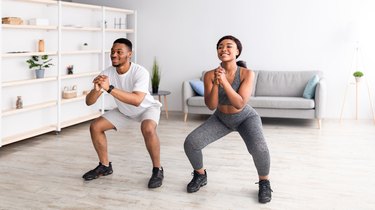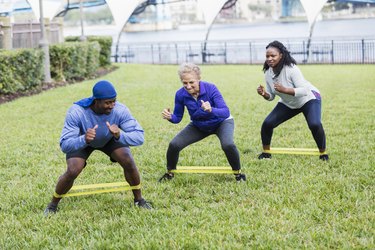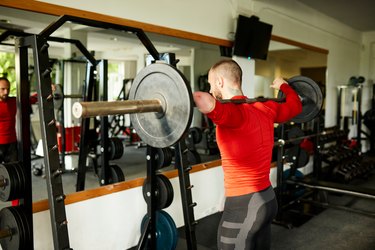

Ace one of the most effective exercises for a stronger lower body and work up to doing 150 reps in a single day with the 30-Day Squat Challenge. Get all the details on the challenge here.
With every squat you do, your body activates roughly 200 muscles (yes, really!) in both your lower and upper body, according to the National Academy of Sports Medicine (NASM). So, in addition to targeting your quadriceps, hamstrings and glutes, squats truly do offer full-body benefits.
But that's not all. Great for all fitness levels and goals, squats are important for everyday functional movements, like standing up from a chair and picking up something off the floor. Strengthening your muscles to do these daily tasks is especially important as you age because, well, if you don't use it, you lose it.
Video of the Day
With that in mind, we rounded up the 30 best squat variations you can do with your body weight, dumbbells, kettlebells and more. Plus, get trainer tips on how to get the most out of each and every squat.
Body-Weight Variations
Whether you're just getting started on your fitness journey or are looking to turn up the bun burn during rounds of high-intensity interval training (HIIT), body-weight squats are versatile, and you can do them anywhere, says athletic trainer Samantha Suarez, CPT, a certified personal trainer at CHAR Fitness.
1. Chair Squat
- Stand in front of (and facing away from) a chair with your feet between hip- and shoulder-width apart and your toes facing forward or slightly outward.
- Keeping your feet flat on the floor and your back straight, brace your core and push your hips back and down to sit down on the chair. (Bend your arms and lift your hands to chest height for balance.)
- Pause here for a brief moment, then brace your core and press through your feet to stand back up.
Squatting onto a chair gives you a chance to take a break halfway through your squat movement, which is helpful for new exercisers and older adults who may not yet be ready to perform full squats, says Robert Linkul, CSCS*D, CPT, owner of Training the Older Adult and National Strength and Conditioning Association board of directors member.
You can swap the chair for progressively shorter boxes as you get stronger.
2. Air Squat
- Stand with your feet between hip- and shoulder-width apart and your toes facing forward or slightly outward.
- Keeping your feet flat on the floor and your back straight, brace your core and push your hips back and down until your thighs are parallel to the ground (or as low as you can comfortably go).
- Pause here for a brief moment, then drive through your heels to stand back up.
It’s not about how low you can squat. It’s about squatting with strong form.
“We all have different bodies, goals and ranges of motion, so squatting super low isn’t always the goal, Suarez says. "A strong squat that gets your thighs parallel to the floor is perfect as long as you do it right."
3. Heels-Elevated Air Squat
- Stand with your feet between hip- and shoulder-width apart and your heels elevated an inch or so on a wedge or a pair of weight plates, toes facing forward or slightly outward.
- Keeping your back straight, brace your core and push your hips back and down until your thighs are parallel to the floor (or as low as you can comfortably go).
- Pause here for a brief moment, then drive through your heels to return to standing.
Elevating your heels may help you maintain proper squat form if you have limited mobility, which can impact your ability to squat from flat ground, says strength coach D’Annette Stephens, CPT. Just make sure to keep your weight balanced throughout your feet.
4. Sumo Squat
- Stand with your feet slightly wider than shoulder-width apart and your toes pointed outward slightly.
- Keeping your feet flat on the floor and back straight, brace your core and push your hips back and down, bending your knees out over your toes to squat down.
- Lower until your thighs are parallel to the floor (or as low as you can comfortably go).
- Pause here for a brief moment, then drive through your heels to stand back up.
The sumo squat emphasizes your inner thighs and glutes, according to Tatiana Lampa, CPT, a certified personal trainer and founder of Training With T.
5. Isometric Squat Hold
- Stand with your feet between hip- and shoulder-width apart and your toes facing forward or slightly outward.
- Keeping your feet flat on the floor and back straight, brace your core and push your hips back and down until your thighs are parallel to the floor (or as low as you can comfortably go).
- Hold at the bottom of the movement for a desired amount of time.
- Then drive through your heels to stand back up.
Holding the bottom position of your squat means your muscles spend more time under tension. You build valuable lower-body (and back!) muscle endurance with every second you hang in there, Linkul says.
6. Jump Squat
- Stand with your feet shoulder-width apart and your toes facing forward or slightly outward.
- Keeping your feet flat on the floor and back straight, brace your core and push your hips back and down until your thighs are parallel to the floor (or as low as you can comfortably go).
- From the bottom of your squat, push through your feet to jump explosively off the ground. (You can extend your arms down along your sides as you do.)
- Land safely with your knees slightly bent.
The explosive nature of jump squats causes your heart rate to skyrocket, meaning you reap more cardiovascular fitness benefits by opting for them, Suarez says. If you have any trouble with jump squats, spend more time on no-impact squat variations before progressing to this move.
7. Squat Jack
- Stand with your feet together and your arms overhead, as if you're doing jumping jacks.
- Jump your feet apart and lower down into a squat, simultaneously circling your arms out to your sides and down in front of your body. Bend your elbows so your hands cross the front of your chest at the bottom of your squat.
- Push through feet to explode back up and jump your feet back together, circling your arms back out and overhead.
Tip
This squat variation has a cardio element, so it’s a great move to add to HIIT circuits.
8. Body-Weight Bulgarian Split Squat
- Stand in front of a box or bench (facing away from it) and reach your left foot back so that the top of your foot rests on the box or bench.
- Hold your hands loosely in front of your chest for balance, brace your core and shift your weight into your front (right) foot. This is the starting position.
- Keeping your neck neutral and back flat, bend your right knee to lower your hips until your front knee is 90 degrees.
- Push through your right foot to extend your leg and return to the starting position.
- Do all reps, then repeat on the opposite side.
Also known as the rear-foot-elevated split squat, this squat variation is great for building unilateral strength (single leg — or arm). That comes in handy for pretty much all exercisers, but especially for those with muscle imbalances or who are rebuilding strength after an injury, says strength and conditioning coach Bryant Harper Thomas, CSCS.
9. Cossack Squat
- Stand in a wide stance with your toes pointed outward slightly and your hands hovering loosely at your chest for balance.
- Keeping your torso upright, brace your core and shift your weight into your right foot.
- Bend your right knee to sink your hips into a squat, keeping your left leg straight and allowing your left toes to rotate up off the floor toward the ceiling.
- Press through your right foot to extend your leg and stand back up.
- Repeat on the other side.
The Cossack squat is a next-level lateral movement for strengthening the muscles around the pelvis (hip bones), Thomas says. Move slowly and with control to maintain proper form during this advanced exercise.
Dumbbell Variations
A strength-training staple, dumbbells are incredibly versatile and great tools for gradually increasing the intensity of your favorite body-weight squat variations.
1. Dumbbell Split Squat
- Get into a staggered stance with your right foot forward and your left leg back with the heel lifted. Keep your torso upright and hold a dumbbell in each hand by your sides.
- Brace your core and lower your hips straight down until your knees form 90-degree angles (or as far as comfortable). Make sure your left hip is stacked above your left knee.
- From here, push through your front foot and back toes to extend your legs and stand back up.
- Do all reps, then repeat on the other side.
Tip
Try practicing a rep or two of this movement without weights first to make sure your leg positioning feels good, Suarez says.
2. Dumbbell Shoulder-Rack Squat
- Stand with your feet shoulder-width apart and your toes facing forward or slightly outward.
- Hold a pair of dumbbells on top of your shoulders with your elbows pointing down.
- Keeping your feet flat on the floor and your back straight, brace your core and push your hips back and down until your thighs are parallel to the floor (or as low as you can comfortably go).
- Pause here for a brief moment, then drive through your heels to stand back up.
This dumbbell squat variation gives you an easy opportunity to add weight to your standard squat and can help you develop the mechanics you’ll need to progress to a barbell front squat, too, Stephens says.
3. Dumbbell Bulgarian Split Squat
- Stand in front of a box or bench (facing away from it) and reach your left foot back so the top of your foot rests on the box or bench.
- Hold a dumbbell in each hand with your arms by your sides.
- Shift your weight into your front (right) foot. This is the starting position.
- Keeping your neck neutral and back flat, bend your right knee to lower your hips until your knee forms a 90-degree angle (or as far as comfortable).
- From here, push through your right foot to extend your leg and return to the starting position.
- Repeat on the other side.
This weighted move levels up your single-leg strength, Thomas says. It’s a challenging one, so be sure to increase the weight slowly and keep your core braced throughout each rep.
Kettlebell Variations
Like dumbbells, kettlebells give you a lot of flexibility to try different squat variations and increase the difficulty and strength- and muscle-building potential of your go-to squat moves.
1. Kettlebell Goblet Squat
- Stand with your feet between hip- and shoulder-width apart and your toes facing forward or slightly outward.
- Hold a kettlebell securely with both hands at chest height and your elbows close to your sides.
- Keeping your feet flat on the floor and your back straight, brace your core and push your hips back and down until your thighs are parallel to the floor (or as low as you can comfortably go).
- Pause here for a brief moment, then drive through your heels to stand back up.
Holding a kettlebell in front of your torso while squatting means your core has to fire up big time, so you’ll enjoy some extra core strengthening as you work your lower body, Lampa says.
2. Kettlebell Goblet Pulse Squat
- Stand with your feet between hip- and shoulder-width apart and your toes facing forward or slightly outward.
- Hold a kettlebell securely with both hands at chest height and your elbows close to your sides.
- Keeping your feet flat on the floor and your back straight, brace your core and push your hips back and down until your thighs are parallel to the floor (or as low as you can comfortably go).
- From the bottom of your squat, press up just a few inches, then lower back down.
- Then drive through your heels to stand back up.
Adding a pulse to the bottom of your squat means your muscles will be under tension for a longer period of time, increasing its muscle-strengthening benefits, Lampa says.
3. Front-Rack Kettlebell Squat
- Stand with your feet shoulder-width apart and toes facing forward or slightly outward.
- Hold the kettlebells in the front-rack position: Your hands close together in front of your chest, elbows wide and the bells resting in the crook of your arms.
- Keeping your feet flat on the floor and back straight, brace your core and push your hips back and down until your thighs are parallel to the ground (or as low as you can comfortably go).
- Pause here for a brief moment, then drive through your heels to stand back up.
In addition to strengthening your lower body, holding two kettlebells in the front-rack position throughout your reps requires a stable core — and, particularly, a stable anterior (front) core, Suarez says. This is a challenging position to maintain, so start with lighter weights.
4. Kettlebell Offset Front-Rack Squat
- Stand with your feet shoulder-width apart and your toes facing forward or slightly outward.
- Hold one kettlebell in a front-rack position. You can extend your free arm out to the side for balance.
- Keeping your feet flat on the floor and back straight, brace your core and push your hips back and down until your thighs are parallel to the floor (or as low as you can comfortably go).
- Pause here for a brief moment, then drive through your heels to stand back up.
Suarez’s favorite squat variation, the offset front-rack squat creates an interesting challenge for your core as you work to stay upright and avoid bending toward your weighted side throughout the exercise.
5. Kettlebell Goblet Cossack Squat
- Stand in a wide stance with your toes pointed outward slightly.
- Flip the kettlebell and hold it bottoms up with both hands at chest height. This is the goblet position.
- Keeping your torso upright, brace your core and shift your weight onto your right foot.
- Bend your right knee to sink your hips into a squat, keeping your left leg straight and allowing your toes to rotate up off the floor toward the ceiling.
- From here, press through your right foot to extend your leg and stand back up.
- Repeat on the other side.
This advanced (and we mean advanced) movement is a great way to build strength at your end range of motion (the bottom of your squat), where most people are the weakest, Thomas says. Moving slowly and with control will also help you build strength and mobility.
Barbell Variations
If you're ready to work with heavy weights — or just try out a piece of equipment guaranteed to make you feel like a superhero — look no further than the barbell. This classic weightlifting tool will help you focus on building strength and muscle in a few different barbell squat variations.
1. Barbell Landmine Goblet Squat
- Secure the barbell into a landmine attachment and stand facing the free end of the bar, holding it with both hands at chest height.
- Your feet should be about shoulder-width apart pointing forward or outward slightly. Brace your core and lean slightly forward.
- Keeping your back flat and core braced, push your hips back and down until your thighs are parallel to the floor (or as low as you can comfortably go with good form).
- Pause here for a brief moment, then drive through your heels to stand back up.
Because the barbell is secured to the floor, this landmine exercise is great for anyone who needs more support in kettlebell goblet squats, Linkul says. Those with shoulder, back and/or knee issues also often find this variation to be more comfortable than others.
2. Barbell Front Squat
- Stand with your feet about shoulder-width apart with your toes pointed straight or outward slightly.
- Place the barbell in the front-rack position so the bar rests across the front of your shoulders and your elbows point straight forward.
- Brace your core and keep your back straight and upright with your elbows high and pointing forward.
- Push your hips back and down until your thighs are parallel to the floor (or as low as you can comfortably go with good form).
- From the bottom of your squat, push through your feet to extend your legs and stand back up.
Tip
The barbell front-rack position can be uncomfortable or difficult to nail at first, because it requires solid wrist, elbow and shoulder mobility, Suarez says. Practice this move with an unloaded bar before adding weight plates up to ensure you feel comfortable and stable.
Additionally, adjusting the distance between your hands on the bar can help you find the position in which you can keep your elbows pointing straight out forward from your shoulders.
3. Barbell Back Squat
- Stand with your feet shoulder-width apart with your toes pointed straight or slightly outward.
- Place the barbell across the back of your shoulders and grip the bar comfortably just outside of your shoulders.
- Brace your core and keep your back straight and upright with your elbows high and pointing forward.
- Push your hips back and down until your thighs are parallel to the floor (or as low as you can comfortably go with good form).
- From the bottom of your squat, push through your feet to extend your legs and stand back up.
The barbell back squat is perfect for building all-over strength — if you do it properly — Stephens says. Keep your chest lifted, engage your back to keep the barbell stable and make sure your back and shins stay parallel with each other as you move through each rep.
4. Barbell Good Morning to Back Squat
- Stand with your feet between hip and shoulder-width apart with your toes pointed straight or outward slightly.
- Place the barbell across the back of your shoulders and grip the bar comfortably just outside of your shoulders.
- Keeping your core braced and your back straight, push your hips straight back and allow your chest and the bar to slower down slightly. (You should feel the tension in your glutes and hamstrings.)
- Hinge only as far as you can comfortably go while keeping the tension in your glutes and hamstrings, then push your hips forward to stand back up.
- From here, push your hips back and down to come into a squat. Lower down as far as you can comfortably go with good form.
- From the bottom of your squat, push through your feet to stand back up.
5. Barbell Overhead Squat
- Stand with your feet about shoulder-width apart with your toes pointed straight or slightly outward.
- Place the barbell in the front-rack position so the bar rests across the front of your shoulders and your elbows point straight forward. Brace your core.
- Bend your hips and knees slightly, then press through your feet to extend your legs and press the barbell overhead, locking out your elbows to keep it pressed up.
- With the bar overhead, continue to brace your core and keep your back straight and upright as you push your hips back and down into a squat.
- Lower down until your thighs are parallel to the floor (or as low as you can comfortably go with good form).
- From the bottom of your squat, push through your feet to extend your legs and stand back up.
Tip
This is the most advanced barbell squat you can do, Thomas says, so don’t sweat if you’re not ready for it. It requires great shoulder and ankle mobility to keep the bar pressed straight up overhead while moving through a squat.
Wearing weightlifting shoes, which elevate your heels a bit, can give you a mobility boost to help you nail this one.
Resistance-Band Variations
Adding a resistance band to your squats can help you target all three muscles in your glutes: the gluteus maximus, medius and minimus. Plus, bands come in handy when you're traveling or don't have space to stash larger pieces of equipment.
1. Mini-Band Squat
- Loop a mini band (or tied-off long resistance band) around your legs just above knees, with your feet shoulder-width apart and toes facing forward or pointed outward slightly.
- Keeping your feet flat on the floor and back straight, brace your core and push your hips back and down until your thighs are parallel to the floor (or as low as you can comfortably go with good form). You can keep your hands in front of your chest for balance.
- Pause here for a brief moment, then drive through your heels to stand back up.
Pressing outward against the resistance band throughout your squat ensures you activate all of your glute muscles, Lampa says. As a result, this squat variation is great both as a warm-up before performing other squats and for strengthening weak side glutes.
2. Lateral Band Walk
- Loop mini band (or tied-off long resistance band) around your legs just above knees, with your feet shoulder-width apart and toes pointing forward.
- Brace your core and sit back into a semi-squat.
- Maintaining pressure on the band, step your right foot out to the right, then follow with your left foot.
- Repeat for the desired number of steps toward the right, then reverse directions and repeat toward the left.
The lateral band walk is a great side-to-side movement for challenging your hip abductors (the muscles that help you move your legs away from your midline), Linkul says. Because most of us don’t do much side-to-side movement, it’s a must for any workout routine.
And all the while, your quads and glutes get a good burn as you maintain that semi-squat position while stepping.
3. Banded Overhead Squat
- Loop a mini band around your legs just below your knees and another band around your wrists. Press your legs out to the sides to create tension in the band.
- Extend your arms overhead, pressing your wrists against the sides of the band to create tension.
- Keeping your core braced and your back straight and upright, push your hips back and down until your thighs are parallel with the floor (or as low as you can comfortably go with good form). Press your knees outward throughout the movement.
- From the bottom of your squat, push through your feet to extend your legs and stand back up.
If you want to master barbell overhead squats, start here, Thomas says. Performing overhead squats with resistance bands requires solid ankle and shoulder mobility but doesn’t involve heavy weights.
Variations Using Other Equipment
These squat variations use other fun fitness equipment, such as TRX bands and BOSU balls, that you might find at your local gym or training facility. Incorporate them to mix up your routine or build up strength for more advanced movements.
1. Suspension Squat
- Stand facing a suspension or TRX rig with the straps adjusted to mid-length.
- Hold the handles in each hand at chest height with your elbows bent so there is no slack in the straps.
- Your feet should be about shoulder-width apart with your toes facing forward or pointing outward slightly.
- Keeping your core braced and your back straight and upright, push your hips back and down to lower into a squat, extending your arms to maintain support from the straps.
- Lower down until your thighs are parallel to the ground or as far as you can comfortably go with good form, pressing your knees outward throughout.
- From the bottom of your squat, push through your feet to extend your legs and return to standing.
If you struggle to perform squats without lifting your heels or leaning your chest forward, TRX squats can help you build mobility with support, Suarez says. It’s also a great way to practice squatting deeper without sacrificing your form.
That said, don’t depend on the straps or use your arms to pull yourself up. Your lower-body muscles are still your main drivers here.
2. Suspension Pistol Squat
- Stand facing a suspension or TRX rig with the straps adjusted to mid-length.
- Hold the handles in each hand at chest height with your elbows bent so there is no slack in the straps.
- Your feet should be about shoulder-width apart with your toes facing forward or pointing outward slightly.
- Brace your core and shift your weight into your right leg, allowing your left foot to lift up off the floor and hover in front of you.
- Keeping your back straight and upright, push your hips back and down into a squat, while extending arms to maintain support from the straps.
- Lower down as far as you can comfortably with good form while relying on your standing right leg.
- From your bottom position, push through your right foot to extend your leg and return to standing
Unassisted pistol squats are darn near impossible, even for many advanced exercisers, but adding some support from a suspension system can help you develop that impressive single-leg strength and balance, Suarez says.
Maintain tension in the straps to get the most out of their support throughout each rep.
3. Overhead Medicine Ball Squat
- Stand with your feet about shoulder-width apart and your toes pointed straight or outward slightly.
- Hold a medicine ball between hands at chest height.
- Brace your core and bend your hips and knees slightly, then press through your feet to extend your legs and press the ball straight up overhead, locking out your elbows to hold it in this overhead position.
- From here, continue to brace your core and keep your back straight as you push your hips back and down into a squat.
- Lower down as far as you can comfortably go with good form, pressing your knees outward throughout.
- From the bottom of your squat, push through your feet to extend your legs and stand back up.
This is another exercise to master if you want to build the ankle and shoulder mobility and stability needed for barbell overhead squats, Stephens says.
Look out for a flaring ribcage, which is a telltale sign that your core isn’t braced. Think about drawing the two sides of your ribs in front together.
4. BOSU Ball Squat
- Place a BOSU ball on the floor with the unstable ball side down and carefully step onto the flat side, with your feet shoulder-width apart and your toes facing forward or pointing outward slightly.
- Keeping your feet pressed into the ball, brace your core and push your hips back and down until your thighs are parallel to the floor (or as low as you can comfortably go with good form). You can keep your hands by your chest to help you balance.
- Pause here for a brief moment, then drive through your heels to stand back up.
The instability of the BOSU ball makes your average body-weight squat so much more difficult as you work to stay stable throughout each rep, Lampa says. Make sure you’re centered on top of the ball and move with control to maintain proper form and reap those balance benefits.
Note: This isn't an exercise to load up with weight. The goal here is to work on your stability and proprioception (your sense of where your body is positioned in space), not your strength.
5. Front-Rack Sandbag Squat
- Stand with a sandbag in the front-rack position, so the bag rests across the front of your shoulders and upper arms and your elbows point straight forward.
- Brace your core and keep your feet about shoulder-width apart with your toes pointed straight or outward slightly.
- Keeping your core braced and back straight and upright, push your hips back and down into a squat.
- Lower down until your thighs are parallel to the floor (or as far as you can comfortably go with good form).
- From the bottom of your squat, push through your feet to extend your legs and stand back up.
A sandbag is a great alternative to other forms of weights for reaping the core and lower-body benefits of the front squat, Stephens says. Because the sand in the bag can shift as you move, it also adds a balance and stability challenge.
